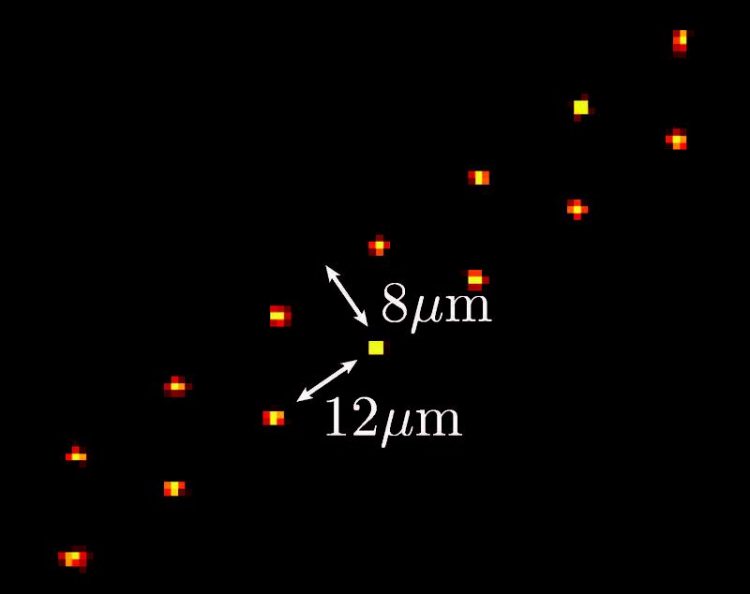Quantum Technology: Observation of a unique quantum state of matter

Picture of the artificial setup consisting of 14 individually trapped and accurately placed atoms, which gives rise to the realisatio of the topological phase. Institut d’optique, Palaiseau
Most states of matter are characterized by the concept of spontaneous symmetry breaking, e.g., the periodic arrangement of atoms in a solid breaks the translational symmetry, or Ferromagnets with all the magnetic moments pointing into the same direction break the rotational symmetry.
However, not all states of matter fall into this paradigm, and especially so-called topologcal phases can not be characterized by a broken symmetry. Examples in condensed matter are the integer as well as the fractional quantum Hall state, and topological insulators.
In the present publiaction, such a topological phase was realized in artificial matter consisting of up to 14 individually trapped atoms excited into Rydberg states. The strong interaction between the Rydberg states gives rise to a quantum many-body system, whose ground state is determined by a topological phase.
Due to the high control in such an artifical setup over the individual atoms, the unique properties of the topological phase could be direclty probed and observed such as the existence of robust edge states, a characteristic gapped excitation spectrum, as well as the appearance of a string order parameter.
The experimental observations performed within the group of Prof. Antoine Browaeys in Palaiseau are in exzellent agreement with the theoretical expectations analyzed by the group of Prof. Hans Peter Büchler in Stuttgart.
Hans Peter Büchler is professor in theoretical physics and head of the institute for theoretical physics III at the University of Stuttgart. This research on quantum many-body systems in artificial matter and the realization of topolgocal phases is funded by the European Research Council within the ERC project SIRPOL.
Furthermore, this research question is also part of the EU flagship on quantum technologies under the aspect of quantum simulators. The research is performed within a strong collaboration bewteen the theoretical group at the University of Stuttgart and the experimental group lead by Prof. Antoine Browaeys at the Institut d’optique in Palaiseau.
The research results are published in 1st August in Science online as first release:
https://science.sciencemag.org/content/early/2019/07/31/science.aav9105
Prof. Hans Peter Büchler, Head of the institute for theoretical physics III at the University of Stuttgart, 0711 685 64975, buechler@theo3.physik.uni-stuttgart.de
https://science.sciencemag.org/content/early/2019/07/31/science.aav9105
Media Contact
All latest news from the category: Physics and Astronomy
This area deals with the fundamental laws and building blocks of nature and how they interact, the properties and the behavior of matter, and research into space and time and their structures.
innovations-report provides in-depth reports and articles on subjects such as astrophysics, laser technologies, nuclear, quantum, particle and solid-state physics, nanotechnologies, planetary research and findings (Mars, Venus) and developments related to the Hubble Telescope.
Newest articles

A ‘language’ for ML models to predict nanopore properties
A large number of 2D materials like graphene can have nanopores – small holes formed by missing atoms through which foreign substances can pass. The properties of these nanopores dictate many…

Clinically validated, wearable ultrasound patch
… for continuous blood pressure monitoring. A team of researchers at the University of California San Diego has developed a new and improved wearable ultrasound patch for continuous and noninvasive…

A new puzzle piece for string theory research
Dr. Ksenia Fedosova from the Cluster of Excellence Mathematics Münster, along with an international research team, has proven a conjecture in string theory that physicists had proposed regarding certain equations….



